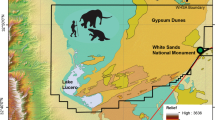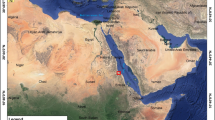Abstract
The Mapoon Mission Cemetery in Cape York, Queensland contains unmarked pre-contact burials with potential national heritage values, despite a lack of formal recognition and protection through State and National heritage listings. Ground-penetrating radar (GPR) showed great potential as a non-intrusive technique to identify over 120 potential unmarked graves and understand mortuary practices at the Cemetery. When integrated with written and oral histories, such information provided new insights into the cultural history of this region, particularly the continuity of Aboriginal occupation and changes in mortuary practices since the establishment of the Mapoon Mission.













Similar content being viewed by others
References
Annan, A. P., and Chua, L.T. (1992). Ground-penetrating radar performance predictions. In Pilon, J.A. (ed.) Ground Penetrating Radar. Geological Survey of Canada Paper 90–4: 5–13.
Bevan, B. W. (1991). The search for graves. Geophysics 56: 1310–1319.
Brown, S., Avery, S., and Goulding, M. (2004). Recent investigations at the Ebenezer Mission Cemetery. In Harrison, R., and Williamson, C. (eds.), After Captain Cook: The Archaeology of the Recent Indigenous Past in Australia, Altamira, Lanham, MD, pp. 147–170.
Buck, S. C. (2003). Searching for graves using geophysical technology: field tests with ground penetrating radar, magnetometry and electrical resistivity. Journal of Forensic Sciences 48: 1–7.
Byrne, D. (1998). In Sad But Loving Memory: Aboriginal Burials and Cemeteries of the Last 200 Years in NSW, NSW National Parks and Wildlife Service, Hurstville.
Conyers, L. B. (2006). Ground penetrating radar techniques to discover and map historic graves. Historical Archaeology 40(3): 64–73.
Conyers, L. B. (2008). Ground penetration radar mapping. In Nadel, D., Lengyel, G., Bocquentin, F., Tsatskin, A., Rosenburg, D., Yeshurun, R., Bar-Oz, G., Bar-Yosef Mayer., D. E., Beeri, R., Conyers, L., Filin, S., Hershkovitz, I., Kurzawska, A., and Weissbrod., L. The late Natufian at Raqefet Cave: The 2006 Excavation Season. Journal of the Israel Prehistoric Society 38: 78–86
Conyers, L. B. (2012). Interpreting Ground-penetrating Radar for Archaeology, Left Coast Press, Walnut Creek, CA.
Conyers, L. B. (2013). Ground-Penetrating Radar for Archaeology, 3rd ed, Altamira Press, Rowman and Littlefield, Latham MD.
Conyers, L. B., and Connell, S. (2007). The applicability of using ground-penetrating radar to discover and map buried archaeological sites in Hawaii. Hawaiian Archaeology Journal 11: 62–77.
CPI (Centre for Public Culture and Ideas), Griffith University. (2009). German Missionaries in Queensland: A Web Directory of Intercultural Encounters. http://missionaries.griffith.edu.au/qld-mission.
Davenport, G. C. (2001). Remote sensing applications in forensic investigations. Historical Archaeology 35(1): 87–100.
Department of Native Affairs Office (1950). File 6G/17, Queensland State Archives, Community and Personal Histories, Brisbane.
IDA (International Development Action Team), Roberts, J., Parsons, M., and Russell, B. (1975–76). The Mapoon Story According to the Invaders: Church Mission, Queensland Government and Mining Company. International Development Action, Fitzroy.
Di Naso, S.M., Gutowski, V.P., Henson, H., and Leonard, R. (2010). Lost graves, Trail of Tears. GPS World. April: 50.
Hey, N. (1901). Report of Mission Work Done at Mapoon Station, North Queensland under the Supervision of the Rev. N. Hey, William Brooks, Brisbane.
Howe-Pienning, A., and Byrne, D. (1998). Caring for Aboriginal post-contact cemeteries, progress report/year 1. Report by NSW National Parks and Wildlife Service, Hurstville.
Killam, E. W. (1990). The Detection of Human Remains, Charles C. Thomas, Springfield, IL.
L’Oste-Brown, S., and Godwin, L. (with Henry, G., Mitchell, T., and Tyson, V.) (1995). “Living Under the Act” Taroom Aboriginal Reserve 1911–1927. Queensland Department of Environment and Heritage, Brisbane
Lomax, K., and Long, A. (1991). Lake Condah Mission Cemetery Investigations. Report to the Kerrup Jmara Elders Aboriginal Corporation, Melbourne.
Long, A., MacKinnon, A. (with contributions by Hawker, J., and Perry, D.) (2000). Ebenezer Mission Cemetery: Microtopographic and Surface Vegetation Study, Stage 3. Report to Aboriginal Affairs Victoria, Melbourne
McConnel, U. (1936/37). Mourning ritual among the tribes of Cape York Peninsula. Oceania 7: 346–371.
McDougall, M., Massie, D., and Cull, J. P. (1997). Ground Penetrating Radar Investigation, former Ebenezer Mission Cemetery. Report to Aboriginal Affairs Victoria, Melbourne.
Moran, M. (2006). Practicing Self-Determination: Participation in Planning and Local Governance in Discrete Indigenous Settlements. Doctoral dissertation, University of Queensland, Brisbane.
Mulvaney, D. J. (1989). Encounters in Place, Australian Heritage Commission, Canberra.
Nobes, D. C. (1999). Geophysical surveys of burial sites: a case study of the Oaro Urupa. Geophysics 64: 357–367.
NPWS (National Parks and Wildlife Service) (2003). Lost But Not Forgotten: A Guide to Methods of Identifying Aboriginal Unmarked Graves, National Parks and Wildlife Service, Hurstville.
Nugent, M. (1998). A Search of the Archives of the Aborigine’s Protection Board and the Aborigine’s Welfare Board for Material Relating to Burials and Cemeteries. Report to the NSW National Parks and Wildlife Service, Hurstville.
Randolph, P., Wilson, V., Frampton, C., and Merritt, C. (1994). Rottnest Island Aboriginal prisoners cemetery: delineation of extent using ground penetrating radar. In Sullivan, M., Brockwell, S., and Webb, A. (eds.), Archaeology in the North: Proceedings of the 1993 Australian Archaeological Association Conference, Australian National University, Darwin, pp. 394–415.
Ranson, D., and Egloff, B. (1988). The application of earth resistivity surveys to Australian archaeological sites. Australasian Historical Archaeology 6: 57–73.
Rhodes, D. (1998). An Archaeological Survey of Ebenezer Mission. Report to Aboriginal Affairs Victoria, Melbourne.
Roth, W. E. (1907). Burial ceremonies and disposal of the dead. Records of the Australian Museum 6(5): 365–403. Plates lxviii–lxxiv.
Ruckman, S. E. (2005). Caring for forgotten graves. Tulsa World, May 17: A.1.
Ruffell, A., and McKinley, J. (2008). Geoforensics, John Wiley, London.
Solla, M., Riveiro, B., Alvarez, M. X., and Arias, P. (2012). Experimental forensic scenes for the characterization of ground-penetrating radar wave response. Forensic Science International 220(1–3): 50–58.
Stanley, J., and Connah, G. (1977). Magnetic evidence of an Aboriginal burial ground at Forster, NSW. In Coutts, P., and Brooks, R. (eds.), A Collection of Papers Presented to ANZAAS 197 August 29th-September 2nd, Section 25A, vol. 2, Memoirs of the Victorian Archaeological Survey, Melbourne, pp. 37–50.
Suhr, J. (2005). Cemetery might hold Trail of Tears remains. Tulsa World, November 25: A.14.
Wallis, L. A., Moffat, I., Trevorrow, G., and Massey, T. (2008). Archaeological geophysics in the Indigenous reburial process: A case study from Ngarrindjeri ruwe, South Australia. Antiquity 82: 750–760.
Ward, A. (1908). The Miracle of Mapoon or From Native Camp to Christian Village, S. W. Partridge and Moravian Mission Agency, London.
Wharton, G. S. (2000). “Mission Time”: A Guide to Queensland Presbyterian Church Records Relating to the Gulf Missions at Aurukun, Mapoon, Mornington Island, Weipa and Thursday Island Mission Agency 1891 to 1978, Presbyterian Church Press, Fortitude Valley.
Yelf, R., and Burnett, A. (1995). Ground Penetrating Radar Survey of Unmarked Cemeteries at Taroom Aboriginal Reserve, Bundulla, Queensland. Report for Department of Environment and Heritage, Rockhampton.
Acknowledgments
We would like to thank the Elders of Mapoon who were involved in the preparation of this paper and who welcomed us into their homes. This paper would not have been possible without their support and generosity. We would like to acknowledge Mapoon Land and Sea Rangers and the Mapoon Interim Land and Sea Advisory Committee for their participation and support in the ground penetrating radar survey. We would also like to acknowledge the support of the Mapoon Aboriginal Shire Council for accommodation and assistance during these investigations. We would like to acknowledge Dr. Sally Babidge and Geoff Wharton who reviewed an early draft of this paper. Thanks to Dr. Sean Ulm, Prof. Paul Memmott, and Dr. Lynley Wallis who provided encouragement during fieldwork throughout 2010. Lastly, we would like to thank Chris Newman of Rio Tino Alcan who prepared historical aerial photographs of Cullen Point which assisted with these investigations and Craig Evenden, who assisted with fieldwork voluntarily throughout June to October 2010 and with the preparation of the figures.
Author information
Authors and Affiliations
Consortia
Corresponding author
Additional information
With contributions by Alma Day, Harriet Flinders, Florence Luff, Susie Madua, Zoe De Jersey, Stan De Jersey, Roy Savo, and William BuschElders, Mapoon, Queensland Australiaemail: virtusheritage@gmail.com
Rights and permissions
About this article
Cite this article
Sutton, MJ., Conyers, L.B. & With contributions by Alma Day, Harriet Flinders, Florence Luff, Susie Madua, Zoe De Jersey, Stan De Jersey, Roy Savo, and William Busch. Understanding Cultural History Using Ground-Penetrating Radar Mapping of Unmarked Graves in the Mapoon Mission Cemetery, Western Cape York, Queensland, Australia. Int J Histor Archaeol 17, 782–805 (2013). https://doi.org/10.1007/s10761-013-0242-1
Published:
Issue Date:
DOI: https://doi.org/10.1007/s10761-013-0242-1




